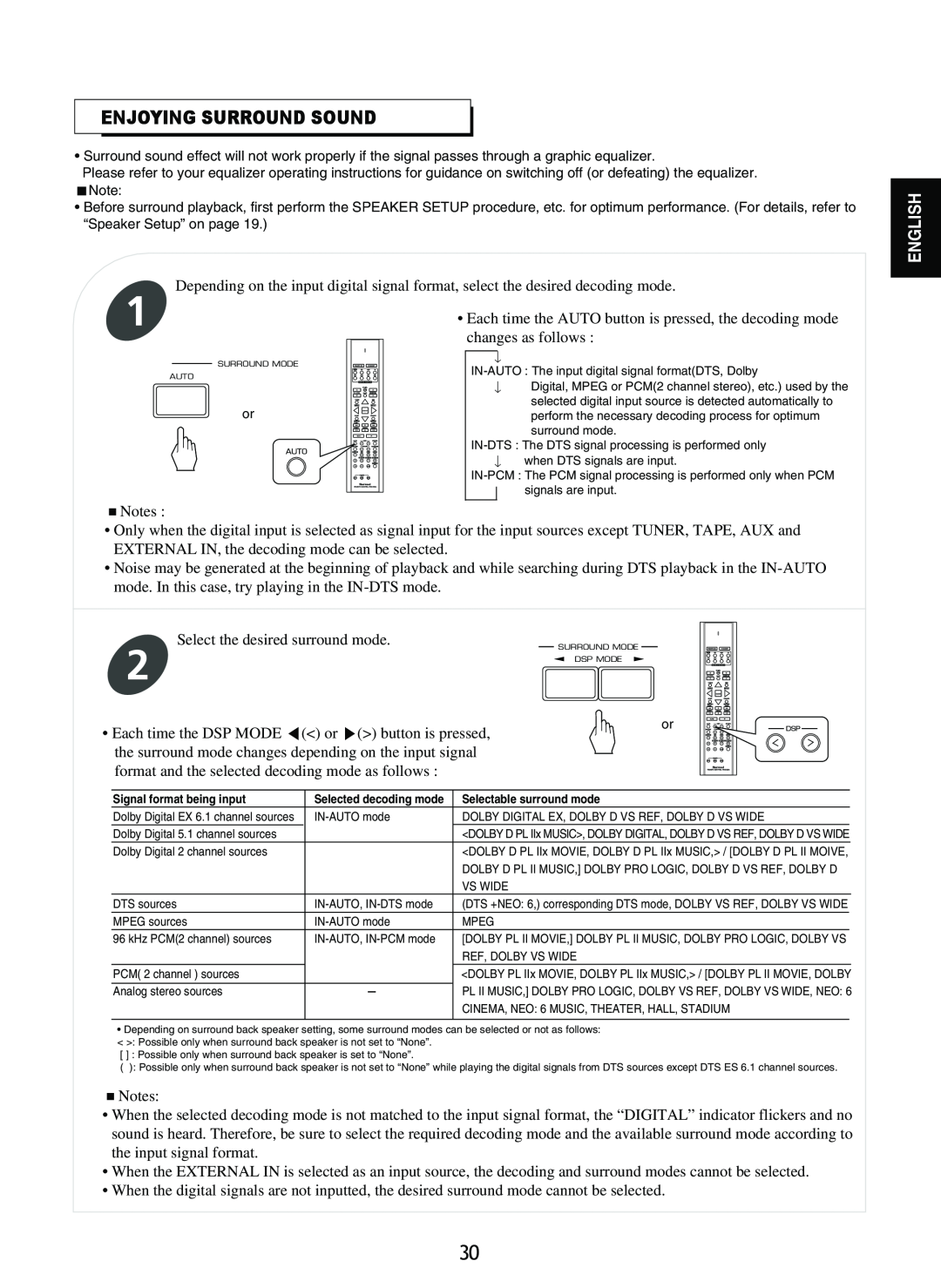
ENJOYING SURROUND SOUND
•Surround sound effect will not work properly if the signal passes through a graphic equalizer.
Please refer to your equalizer operating instructions for guidance on switching off (or defeating) the equalizer. Note:
•Before surround playback, first perform the SPEAKER SETUP procedure, etc. for optimum performance. (For details, refer to “Speaker Setup” on page 19.)
Depending on the input digital signal format, select the desired decoding mode.
1 | • Each time the AUTO button is pressed, the decoding mode | |
| ||
| changes as follows : | |
SURROUND MODE | ||
AUTO | ||
Digital, MPEG or PCM(2 channel stereo), etc.) used by the | ||
| ||
or | selected digital input source is detected automatically to | |
perform the necessary decoding process for optimum | ||
| surround mode. | |
AUTO | ||
when DTS signals are input. | ||
| ||
| ||
| signals are input. |
Notes :
•Only when the digital input is selected as signal input for the input sources except TUNER, TAPE, AUX and EXTERNAL IN, the decoding mode can be selected.
•Noise may be generated at the beginning of playback and while searching during DTS playback in the
ENGLISH
Select the desired surround mode.
2
• Each time the DSP MODE (<) or (>) button is pressed, the surround mode changes depending on the input signal format and the selected decoding mode as follows :
SURROUND MODE
DSP MODE
or | DSP |
Signal format being input | Selected decoding mode | Selectable surround mode | |
Dolby Digital EX 6.1 channel sources | DOLBY DIGITAL EX, DOLBY D VS REF, DOLBY D VS WIDE | ||
Dolby Digital 5.1 channel sources |
| <DOLBY D PL IIx MUSIC>, DOLBY DIGITAL, DOLBY D VS REF, DOLBY D VS WIDE | |
Dolby Digital 2 channel sources |
| <DOLBY D PL IIx MOVIE, DOLBY D PL IIx MUSIC,> / [DOLBY D PL II MOIVE, | |
|
| DOLBY D PL II MUSIC,] DOLBY PRO LOGIC, DOLBY D VS REF, DOLBY D | |
|
| VS WIDE | |
DTS sources | (DTS +NEO: 6,) corresponding DTS mode, DOLBY VS REF, DOLBY VS WIDE |
| |
MPEG sources | MPEG | ||
96 kHz PCM(2 channel) sources | [DOLBY PL II MOVIE,] DOLBY PL II MUSIC, DOLBY PRO LOGIC, DOLBY VS | ||
|
| REF, DOLBY VS WIDE | |
PCM( 2 channel ) sources |
| <DOLBY PL IIx MOVIE, DOLBY PL IIx MUSIC,> / [DOLBY PL II MOVIE, DOLBY | |
|
|
| |
Analog stereo sources | - | PL II MUSIC,] DOLBY PRO LOGIC, DOLBY VS REF, DOLBY VS WIDE, NEO: 6 | |
|
| CINEMA, NEO: 6 MUSIC, THEATER, HALL, STADIUM | |
|
|
|
|
•Depending on surround back speaker setting, some surround modes can be selected or not as follows: < >: Possible only when surround back speaker is not set to “None”.
[ ] : Possible only when surround back speaker is set to “None”.
( ): Possible only when surround back speaker is not set to “None” while playing the digital signals from DTS sources except DTS ES 6.1 channel sources.
Notes:
•When the selected decoding mode is not matched to the input signal format, the “DIGITAL” indicator flickers and no sound is heard. Therefore, be sure to select the required decoding mode and the available surround mode according to the input signal format.
•When the EXTERNAL IN is selected as an input source, the decoding and surround modes cannot be selected.
•When the digital signals are not inputted, the desired surround mode cannot be selected.
30
